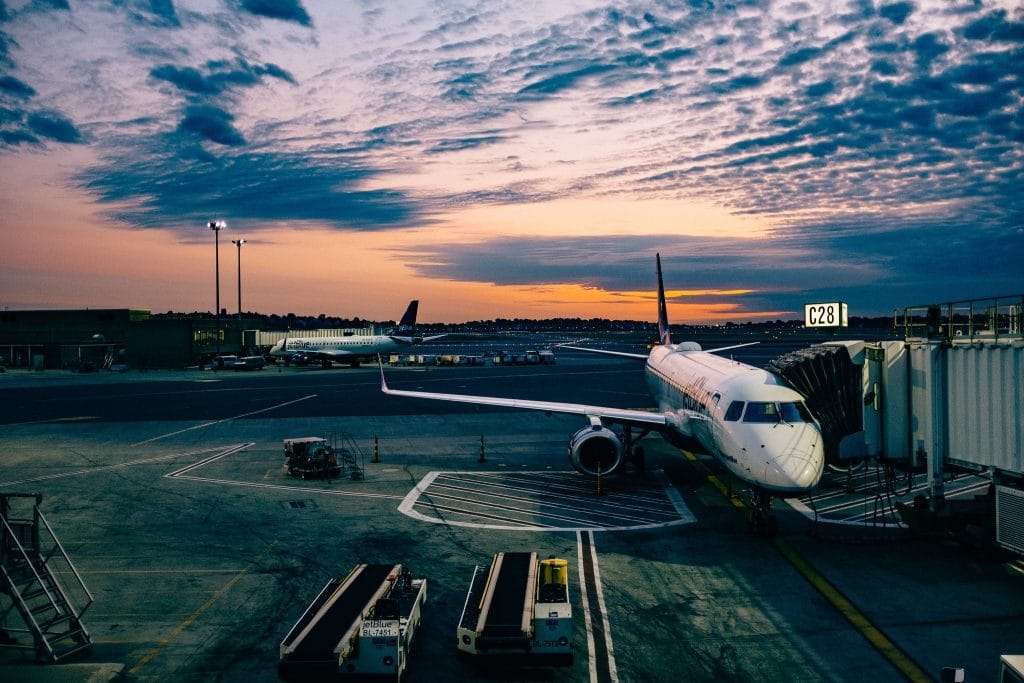Net-zero air travel inches closer to reality with the first commercial passenger flight powered by sustainable jet fuel.
United Airlines made history yesterday as it flew the world’s first passenger flight on the maximum allowable sustainable aviation fuel (SAF).
One hundred passengers were on the maiden flight, including United Airlines’ CEO Scott Kirby and two Illinois congressmen, Democrats Sean Casten and Brad Schneider. The flight went from Chicago to Washington, D.C. using about 500 gallons of SAF. The sustainable fuel produces about 80 percent fewer emissions than petroleum-based fuel.
“Climate change is the biggest issue our generation faces and our generation has to solve it. The implications if we don’t are catastrophic,” Kirby said in a statement.
Sustainable aviation fuel
The SAF powering the United 737 MAX 8 aircraft is made with byproducts from cooking oil and agriculture, among other sources.
“This is really a major milestone demonstrating that the future should be flying sustainably,” said Lauren Riley, managing director of global environmental affairs and sustainability at United Airlines. “Today, at least at United Airlines, 98% of the greenhouse gas emissions across our entire operations are from consuming jet fuel as we fly our planes. And transitioning to using alternative fuels, like sustainable aviation fuel, is really, really important because it pulls down the carbon dioxide emissions from flying.”
Current regulations allow for only 50 percent sustainable jet fuel, but the airline still called it a victory in the industry’s efforts to decarbonize.
According to Congressman Schneider, two percent of all greenhouse gas emissions come from aviation. “SAF cuts that by at least 50 percent or higher. If we convert the entire fleet, which is the long-term goal, that eliminates one percent of greenhouse gas emissions in just one initiative,” he said.

“Sustainable aviation fuel plays an important role in the carbon neutrality goal,” said Argonne National Laboratory Senior Scientist Michael Wang, who was also on the flight. “Although battery-powered airplanes are foreseeable for short trips in the future, “for cross-country or international trips, we still need liquid fuels.”
Last February, Rolls Royce tested the first flight powered by 100 percent SAF in a jet engine.
“Sustainable aviation fuels have the potential to significantly reduce the carbon emissions of our engines and combining this potential with the extraordinary performance of our Pearl engine family brings us another important step closer to enabling our customers to achieve net zero carbon emissions,” Dr. Joerg Au, Chief Engineer—Business Aviation and Engineering Director Rolls-Royce Deutschland, said in a statement.
Nitrous oxide emissions
MIT engineers are looking at technology that could make flying a lot like driving a hybrid car—and tackle another industry issue: nitrous oxide emissions (NOx). The new concept in airplanes could help to reduce 95 percent of NOx. The concept plane design and its environmental impact are detailed in the journal Energy and Environmental Science.
Shifting to a hybrid model would only require 0.6 percent more fuel, according to the researchers.
“This would be many, many times more feasible than what has been proposed for all-electric aircraft,” Steven Barrett, one of the study’s authors and an MIT professor of aeronautics and astronautics, said in a statement. “This design would add some hundreds of kilograms to a plane, as opposed to adding many tons of batteries, which would be over a magnitude of extra weight.”
The new design involves a relocation of the plane’s gas turbines, typically found under the wings. The MIT team’s concept moves them to the cargo hold, where, instead of gas, they would power propellers or fans through an electric-powered generator.

This relocation, the team says, avoids the need to adapt the plane’s engine. The change instead works similar to diesel vehicles and would keep the same power generation, only without the air pollution. The generators would clean exhaust, converting nitrogen oxide into nitrogen and water. It would then disperse the converted nitrogen into the atmosphere.
“This would still be a tremendous engineering challenge, but there aren’t fundamental physics limitations,” Barrett said. “If you want to get to a net-zero aviation sector, this is a potential way of solving the air pollution part of it, which is significant, and in a way that’s technologically quite viable.”
Reducing NOx emissions isn’t just critical for the health of the planet. It could also save thousands of lives. NOx generated by air travel is linked to 16,000 premature deaths every year, according to a 2019 MIT study. That study found NOx emissions to be more damaging to the air quality and human health than to the climate.
According to the World Wildlife Fund, if the global aviation sector were a country, it would be among the top-ten carbon-pollution nations.
“The compounded effect of ozone at such a low altitude and NOx, which acts as a precursor greenhouse gas, means that aviation is responsible for around five percent of global CO2 emissions annually, at a minimum,” EcoWatch explains.
The EPA says fine particulate matter, produced by NOx, is the pollutant with the biggest impact on human health. It’s linked to respiratory conditions including asthma, cardiovascular disease, and some forms of cancer.
Is net-zero air travel achievable?
The MIT team is also working on developing another climate-friendly model: a zero-impact airplane. It would not create any emissions, according to the team.
“We need to get to essentially zero net-climate impacts and zero deaths from air pollution,” Barrett said. “This current design would effectively eliminate aviation’s air pollution problem. We’re now working on the climate impact part of it.”
United says it proved sustainable fuel performs exactly like its emissions-heavy counterpart. The airline conducted a test flight in October, which it said proved the efficacy of the eco fuel.

Now, it’s hoping to meet the FAA fuel requirements for regular flight and government approval. There’s just one problem: there isn’t enough of SAF to go around.
“The reality is, at least from where the technology is right now, hydrogen and electric will be most useful in our shorter-distance flying,” Riley told Fast Company. “So commuter regional distances, not long haul. As we look at long haul, we’re going to need an alternative fuel that’s liquid for the energy density so that we can travel those distances.” For United, the test flight proved that’s possible.
Riley says the amount of SAF available is “far less than 0.1% of our fuel supply, and we’re the market leader,” she says. “So there’s just not enough right now, and that’s unacceptable.”


